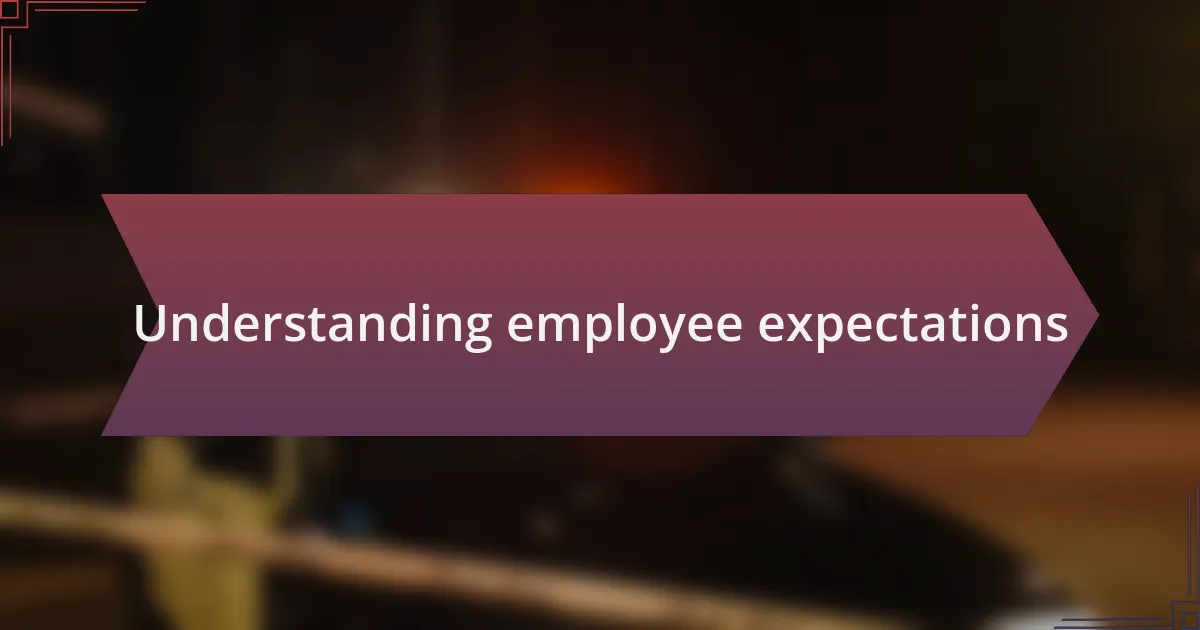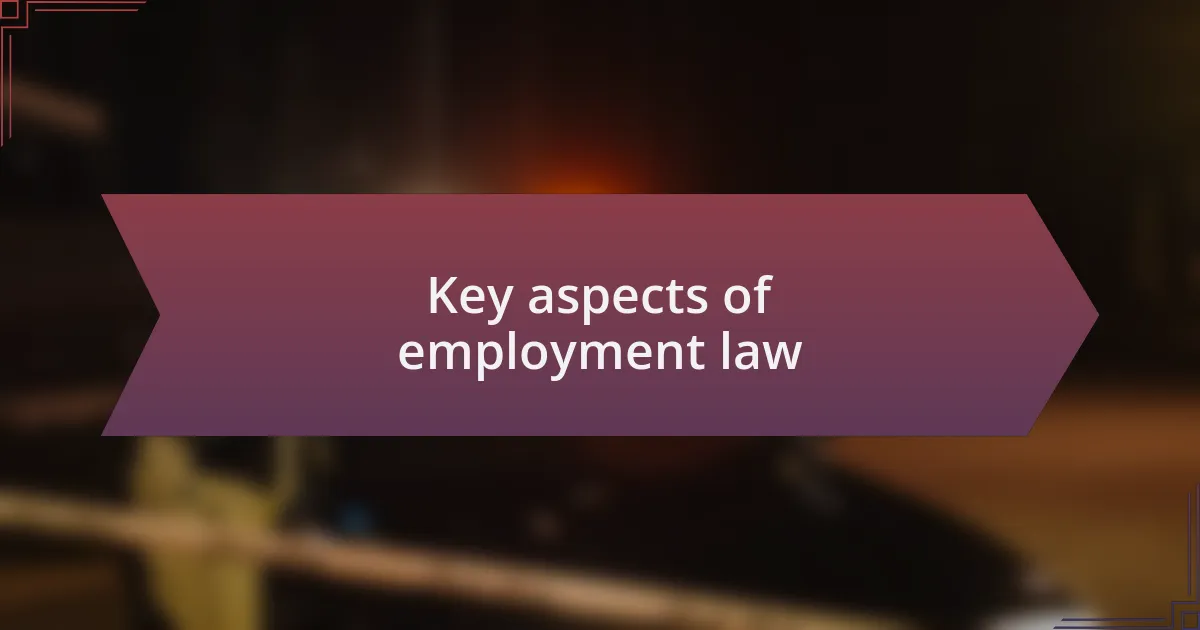Key takeaways:
- Understanding employee expectations requires active listening and creating an open environment for communication.
- Managing expectations is essential for preventing burnout and fostering a positive workplace culture.
- Regular check-ins and goal-setting can enhance employee engagement and accountability.
- Flexibility and adaptability in managing team expectations can turn challenges into opportunities.

Understanding employee expectations
Understanding employee expectations goes beyond merely recognizing what employees want; it involves genuinely listening to their needs. I remember a time when a team member expressed feeling overlooked in project discussions. That simple conversation opened my eyes to the importance of being attuned to individual expectations. Have you ever considered how a small acknowledgment can significantly impact morale?
Sometimes, expectations are unspoken. I’ve found that creating an open environment where employees feel safe to voice their concerns is crucial. For instance, during team meetings, I encourage everyone to share their thoughts, which often leads to revealing hidden expectations. Have you thought about how silent expectations can affect team dynamics?
Furthermore, setting clear goals and regularly checking in can help align mutual expectations. I once helped a colleague clarify their career path, which not only motivated them but also strengthened our working relationship. Isn’t it fascinating how transparent communication can bridge gaps in understanding?

Importance of managing expectations
Managing employee expectations is vital for fostering a positive workplace culture. I recall a situation where I introduced a new project timeline without discussing it with my team first. The confusion and frustration that followed reminded me of how critical it is to communicate effectively. Have you ever seen how a lack of clarity can lead to misaligned efforts and decrease motivation?
Beyond just communication, understanding and managing expectations helps prevent burnout. I’ve noticed that when I check in on workloads and adjust expectations based on genuine feedback, it creates a sense of trust. This approach not only enhances productivity but also cultivates a more engaged work environment. Wouldn’t you agree that a happy employee is often a more productive one?
Additionally, managing expectations sets the stage for accountability and growth. When goals are clearly defined and understood, employees are more likely to take ownership of their responsibilities. In my experience, this creates a greater sense of accomplishment. Isn’t it rewarding to witness your team thrive when they know what is expected of them?

Key aspects of employment law
Understanding employment law is crucial for both employers and employees. At its core, employment law governs the rights and obligations that come into play in the workplace. For instance, when I navigated a dispute over unpaid wages, I learned firsthand the importance of knowing legal boundaries. It made me realize that being informed can protect both parties and foster a healthier work environment. Have you ever faced a situation where understanding legal frameworks could have changed the outcome?
Another key aspect is workplace safety regulations. While it might seem like a dry topic, I’ve found that prioritizing safety significantly impacts employee morale. I remember a time when a colleague was injured because safety protocols were overlooked. That incident reinforced the necessity of compliance with safety laws. When everyone feels safe at work, they naturally perform better. Wouldn’t it be great if every organization put safety at the forefront?
Moreover, anti-discrimination laws play a vital role in shaping a fair workplace. My experience has shown that when employees feel valued for their diversity, it enhances collaboration and creativity within the team. I once participated in a workshop about inclusivity that opened my eyes to biases I hadn’t noticed. How often do we consider our roles in fostering an inclusive culture? Promoting equality isn’t just a legal requirement; it’s an ethical imperative that can transform workplace dynamics for the better.

Communicating effectively with employees
Effective communication with employees is the cornerstone of a productive workplace. I recall a time when I implemented regular check-ins, and the resulting dialogue opened doors to concerns that might have otherwise gone unaddressed. These conversations allowed me to tune into employee needs and expectations, which I believe made a significant difference in how they perceived their roles.
Listening actively is just as important as sharing information. There was an instance when an employee approached me about feeling overwhelmed with their workload. Instead of brushing it off, I took the time to listen and together we found a solution to redistribute tasks. This not only alleviated their stress but also built a sense of trust. I often wonder, how many managers miss opportunities like this simply because they don’t take the time to listen?
Transparency also plays a vital role in communication. In my experience, when I shared the reasoning behind changes within the organization, employees felt more connected to the decisions being made. I remember telling my team about budget cuts and how we’d have to be more resourceful moving forward. Instead of fearing the worst, they appreciated the honesty and collaboration that followed. How do you think employees respond when they feel included in the decision-making process? From my perspective, it fosters loyalty and a more engaged workforce.

Setting realistic performance goals
When it comes to setting realistic performance goals, I find it crucial to align them with both the team’s capabilities and organizational objectives. I once had a team member who was enthusiastic but struggled to meet an overly ambitious target I set. After a candid discussion, we reassessed the goal and broke it into smaller, achievable milestones. This not only boosted their confidence but also led to remarkable progress in a short time. Don’t you think that achievable goals fuel motivation rather than create frustration?
Moreover, I emphasize the importance of involving employees in the goal-setting process. There was a project where I invited my team to contribute their insights on what they believed was realistic for their own roles. The engagement was palpable, and together we crafted goals that felt both attainable and meaningful. It was rewarding to see the newfound ownership each member took in their work. Can goals feel more motivating when employees have a hand in shaping them?
Lastly, I always recommend revisiting performance goals regularly to gauge progress and make necessary adjustments. I remember initially setting quarterly goals without much follow-up, which led to a disconnect as circumstances evolved. By incorporating monthly reviews and open dialogue, I encouraged my team to voice when they felt overwhelmed or needed more support. How often do we leave our employees in the dark about their paths to success? Keeping the conversation ongoing creates a collaborative environment and helps ensure everyone remains on the same page.

Personal experiences in management
When I first stepped into a management role, I quickly realized that understanding individual team members was key. I had a promising intern who was filled with ideas but often felt overwhelmed by expectations. One day, as we sat down to discuss his progress, I noticed the anxiety shadowing his enthusiasm. This prompted me to share my own early career struggles, and it helped bridge the gap between us. It taught me that showing vulnerability can foster trust and openness.
I recall a time when I had to navigate differing expectations from upper management and my team. One ambitious project came with a tight deadline, and I could sense the rising stress within my group. I decided to take a step back and hold a team meeting where everyone could voice their feelings and suggestions. By creating a safe space for dialogue, we redefined our approach, balancing ambition with realism. Have you ever witnessed a team come together to overcome a daunting challenge?
In another instance, I learned the hard way that consistency in communication is vital. I once launched an initiative without regularly updating my team, leading to confusion and frustration. After implementing weekly check-ins, I saw not only a significant improvement in their performance but also a renewed sense of camaraderie. It was a reminder that sometimes, just a little bit of open communication can go a long way in aligning expectations and maintaining morale. Isn’t it fascinating how simple adjustments can lead to major breakthroughs?

Strategies for aligning expectations
One effective strategy I’ve found for aligning expectations is to set clear, measurable goals at the outset. I remember embarking on a project with my team where we were tasked with increasing our outreach by a certain percentage. To ensure we were on the same page, we broke the goal down into smaller, achievable milestones. This clarity not only motivated everyone but also made it easier for us to track our progress together. Have you ever noticed how specific targets can lift a team’s spirits?
Another approach that has served me well is to engage in active listening during one-on-one sessions. Early in my management career, a team member expressed frustration over perceived misalignment with project goals. Instead of dismissing her concerns, I took the time to really understand her perspective. By genuinely acknowledging her feelings and validating her input, we cultivated a more collaborative atmosphere. It made me realize that taking the time to listen deeply can transform a tense situation into a productive conversation.
Lastly, I advocate for a flexible mindset when dealing with expectations. There was a time when a sudden client change altered our project scope, leaving my team feeling demoralized. Instead of sticking rigidly to our original plan, I encouraged everyone to brainstorm how we could adapt. This pivot not only salvaged the project but also reinforced the idea that adaptability is key in managing expectations. Have you ever experienced a situation where flexibility turned a challenge into an opportunity?